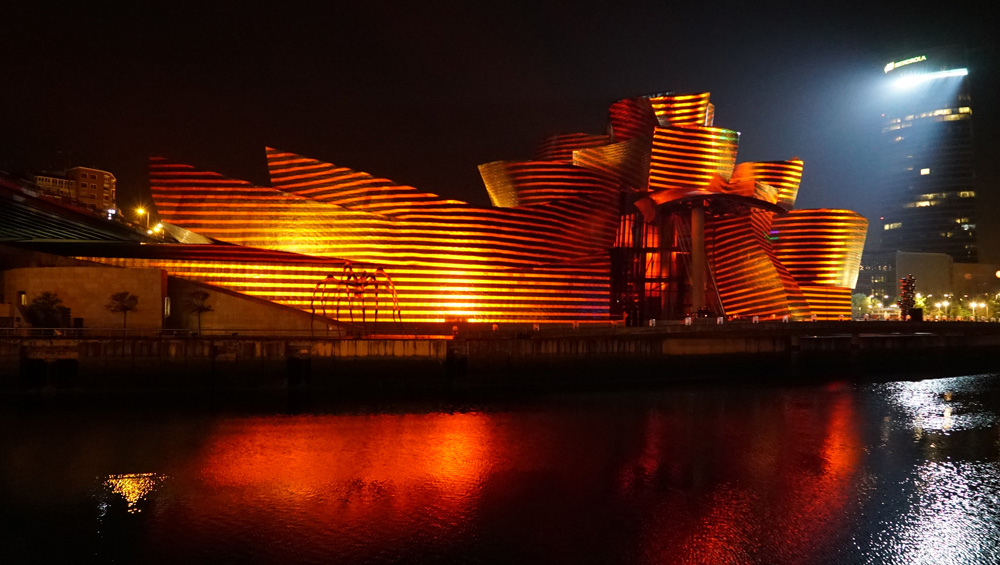
by VERONICA SIMPSON
The company 59 Productions first came to global attention with its lavish, colourful audiovisual and light elements for the opening sequence of London’s 2012 Olympics, working alongside the film director Danny Boyle to make it “the greatest show on Earth”. It was broadcast to a live TV audience of more than a billion viewers worldwide. Founding director Leo Warner, his fellow directors and an ever-growing team have gone on to infuse sophisticated sound and audiovisual technology into blockbuster exhibitions such as David Bowie Is, for the V&A, and project compelling visual creations on to some of the world’s most iconic buildings, including the Sydney Opera House (2014), Hampton Court Palace in London (2015), and a commemorative 20-minute animated artwork for the Guggenheim Bilbao’s 20th anniversary celebration in October 2017.

Olympic Opening Ceremony, London 2012. 59 Productions.
Warner and his fellow directors, Mark Grimmer, Lysander Ashton, Richard Slaney and Anna Jameson, have worked consistently in theatre, notably with the National Theatre of Scotland, with Rufus Norris on the international hit War Horse, and on multiple productions with director Katie Mitchell. Their pioneering methods of “live film-making” have won them a slew of Olivier and Tony awards, and they have produced visually spectacular shows for the biggest names in theatre, including the National Theatre and Royal Opera House in London and the Metropolitan Opera in New York. In 2017, they brought all the key creative and production skills in-house, including their own architecture department, celebrating with an adaptation of Paul Auster’s City of Glass.
Warner, as design director, has overseen many of the company’s most visually and technically ambitious productions. Most recently, he directed a groundbreaking commission from Manchester International Festival to realise a stage version of Italo Calvino’s slender, poetic and philosophical novel Invisible Cities. This sparked 59’s first collaboration with dancers - Ballet Rambert - under the choreographic leadership of Sidi Larbi Cherkaoui, along with actors, projections, animation and specially commissioned music. They even constructed a special theatre in one of Manchester’s former train depots, Mayfield. it opened in July 2019, and will show this September, in Brisbane, Australia. Just days after Invisible Cities opened, 59’s team were out in Washington, setting up a commemorative display on the 50th anniversary of the Apollo 11 voyage. A collaboration between 59 Productions, The Smithsonian’s National Air and Space Museum and award-winning composer Jeff Beal, this free, public event was held across two evenings, and saw the Washington Monument transformed with a 17-minute artwork that combined archive footage with bespoke animations.
Warner studied English literature before turning his hand to graphic design, and then combined his visual and literary talents to pioneer a new kind of multimedia storytelling.
Veronica Simpson: Invisible Cities has just opened at Manchester International Festival (MIF) [it ran from 2-14 July]. I read you were a fan of the book, but thought it would be impossible to stage. So how did that project happen?
Leo Warner: Jenny (Melville, 59 Productions’ head of architecture) and I talked about it as an impossible proposition. I think it was before we did City of Glass, which was the first 59 Productions project conceived and designed and produced by us, as a multidisciplinary thing. And we had this conversation about Calvino and whether it’s possible to make architecture speak narratively. We were debating what tools we’d need in order to tell that story. We thought, obviously, you’d need Calvino’s words and therefore actors’ voices, but it’s about humanity and the populations in the city as much as the buildings, so you’d need humanity.
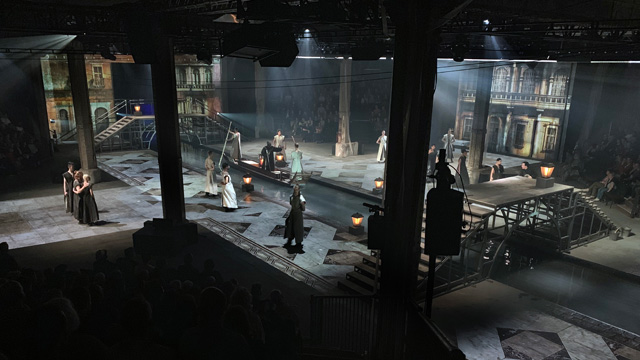
Invisible Cities. Conceived and created by 59 Productions for Manchester International Festival 2019.
Dancers are in a sense the most extraordinary, flexible thing because they can embody either architecture or people or ephemeral concepts. So we said we need a big found space that we can own and build. I think I saw Mayfield Depot (the venue) when Massive Attack played there, which was four years ago. It didn’t occur to me to use it until we started talking to MIF about it. Jenny and I had this wish list of actors, dancers, found space, technology and water. I thought: “Well, that’s never going to happen.” Anna (Jameson) - who was involved in the company when it was in its infancy in 2001, then went off to the National Theatre and elsewhere - had just rejoined us to produce City of Glass. Her skill is getting impossible projects to happen. She built partnerships. She introduced us to Rambert and she forged the relationship with MIF.
They have got this extraordinary remit of only doing world premieres. Nobody was sure if they would continue with that when Alex (Poots, the former director) left (he is now at the Shed in New York) and they have. However, it had to extend beyond those three partners to other international co-producers. We brought in people such as Karl Sydow (producer of The Last Ship and City of Glass), who is one of our biggest supporters. The consortium coalesced organically around the idea. And obviously MIF drove it forward. It became a huge undertaking. It would never have existed if it wasn’t for the international relationships we have. It’s a co-production with Kuwait’s National Theatre (at the Sheikh Jaber Al-Ahmed Cultural Centre), where we have been able to do some really interesting work, and SMG (Shanghai Media Group).
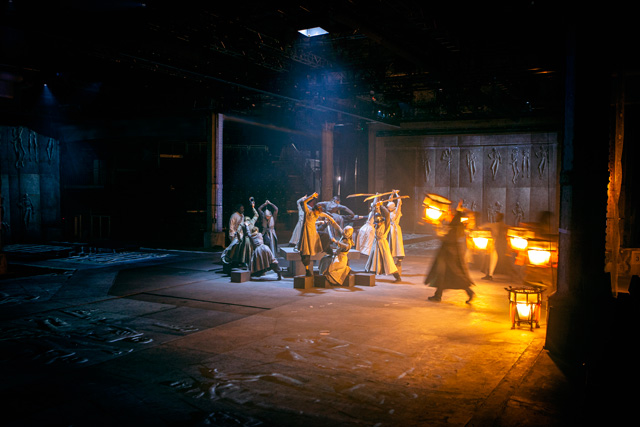
Invisible Cities. Conceived and created by 59 Productions for Manchester International Festival 2019.
Both parties said: “This is interesting: we don’t know whether it will work for our audiences, but we’ll support it.” And, actually both of those organisations are positive about the possibility of taking it forward into those regions in foreign languages, because it’s all about language and communications and internationalism and nation-building and cross-cultural collaboration. I love the fact that that’s also how the producing model is formed.
VS: So where does the show go next?
LW: It starts in Brisbane in September. Then the next confirmed date is Hong Kong in 2020. Everything else is confidential. We are hoping and expecting for multiple language versions to exist in the next couple of years, but always with Rambert. It is the dance company co-producing it. The production will continue to evolve around that. I think it’s worth saying that one of the problems with making work for a festival is that it gives you a very short lead time: less than a week of technical rehearsals, three previews and then you’re up. Normally, with work of this scale and complexity, if you were at the National Theatre, you’d have two or three weeks, on Broadway nine weeks.
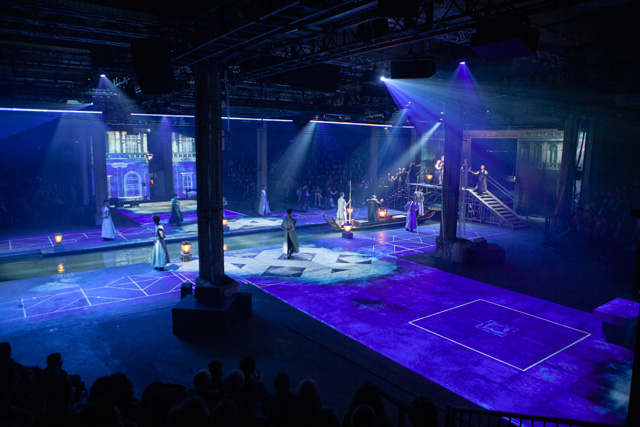
Invisible Cities. Conceived and created by 59 Productions for Manchester International Festival 2019.
I think the world has to embrace the fact that what we’re doing is offering glimpses into a really ambitious project, but it’s still in development. If it wasn’t for the fact that this had a future life, I’d be a bit sad. We’ve got so far, but I’d really love to drill into the drama more fully. We did some great dramaturgical work, but I would really like to get into the essence of the philosophical conversations, continuing to work with the actors on meaning - what the whole production is saying, not just the characters. It’s not about adding more, but everything’s just coming into focus.
VS: Just as the Invisible Cities production was drawing to a close in Manchester, something else enormous was kicking off in Washington – the Apollo 50th anniversary celebration. (This event was happening within days of this interview.) Is the creative work all done and dusted?
LW: No, it’s being made right now. With maybe one or two exceptions, we always work right up to the opening. We have a team of animators in Washington on the wall right now, making tweaks, making connections. We do such a tiny amount of work that is screen-based, it’s all an interaction between a physical space and light, and the realities of the physical space and the volumetrics of an arena or monument have to affect the process so that every time we show up and try something on a building or a site or a theatre we think: “Ah, great. Now, I know what to do.” And we redo significant portions of work. Similarly with Invisible Cities, we had a team of animators in a cabin in that venue constantly reiterating work.
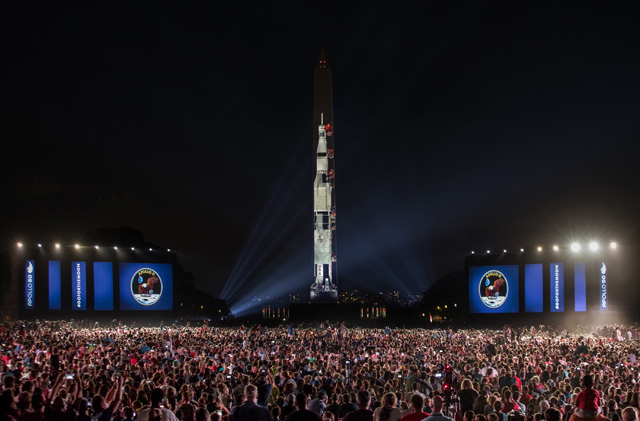
Apollo 50: Go for the Moon, created by 59 Productions, conceived and commissioned by the Smithsonian’s National Air and Space Museum to mark the 50th anniversary of the Apollo 11 voyage. Photo: Evelyn Hockstein.
VS: So, given that you work across so many fields – museums, events, theatre – and work with so many different people, how do you find your collaborators and clients, or do you have people queueing up to work with you?
LW: Increasingly, people do come and find us. There is something about the eclectic nature of our projects, and our portfolio is so extensive now that it kind of speaks for itself. And people can identify - especially if they have got something unusual in their head - that we have various different routes into distilling and then delivering a story. We have many tools at our disposal on that front. Including now a big company of dancers.
VS: What would you say is the 59 Productions signature?
LW: It’s something with story at its core and it’s always got to have a really strong narrative imperative and then the expression of that is generally a combination of an interaction between a physical element and an ephemeral element - combining sculpture and architecture, and scenic design, or an existing building with light, sound, music and performance.
VS: How do clients find you?
LW: With the Guggenheim, it came directly from them. They had seen our work with Sydney Opera House and possibly Hampton Court. We don’t treat buildings as canvases. We treat them as characters, participants. I think they had a degree of confidence that what we were doing was helping their building to perform rather than making it into a screen. I do find that form of architectural projection abhorrent - where you disguise the building as something that it isn’t and you dominate it.

Reflections - 20th anniversary celebrations for Guggenheim Museum Bilbao. Created by 59 Productions. Photo: Justin Sutcliffe.
VS: Now you have your team of 35, I guess everyone has fingers in different pies, so is there lots of cross-fertilisation of ideas and contacts?
LW: We are very lucky that we have a big international team. Also a factor is that there is not a lot of work in any one place: opportunities arise all over the world. Whether it’s existing work or new commissions, the more you do, the more people see. We’re very lucky that we have got a significant presence not just in America or Canada, but in China and Japan and all over the Middle East. Interestingly, we don’t do a huge amount in Europe. I would love to do more work in mainland Europe – especially in the UK. But there is an internationalism about the company now that I really enjoy. Our team is culturally very diverse as well. The fact that we’re working all over the world in different languages quite frequently, it just feels right, given the kind of company we are. Invisible Cities may be the best example of this, but we’re quite often celebrating humanity and the ingenuity of humans.
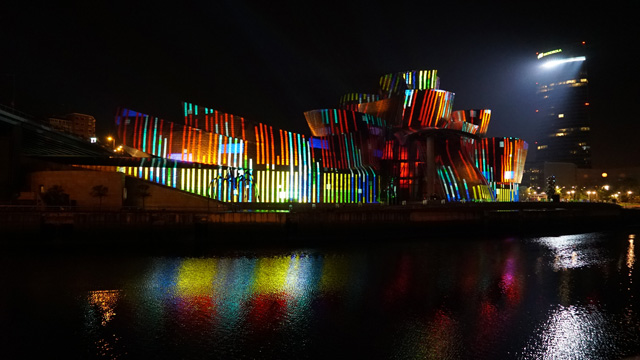
Reflections - 20th anniversary celebrations for Guggenheim Museum Bilbao. Created by 59 Productions. Photo: Justin Sutcliffe.
VS: Certain parts of the world, such as Asia, seem particularly interested in using technology as a creative tool. They seem to be driving the push to incorporate digital technology more fully into the art arena.
LW: I agree, but it can be a bit of a trap. If you put the technology first, you can end up with very hollow artwork. I think it’s absolutely fine for technology to drive the funding, but then it’s up to the artists to invert the relationships. The client might think this is about technology, but we are going to make it about the story. You can use the technology to sell an idea, but if it is the idea then you’re in real trouble.
We have definitely benefited from opportunities where people have said we will fund you to use this particular piece of technology. And we will say great, that’s interesting because I’ve had this idea which this particular bit of technology might be able to service. But if you try it the other way around, you can tie yourself in knots.
VS: Which art form or forms do you take most inspiration from?
LW: The thing that I find inspirational to some extent is literature. I’m interested in particular novels that explore alternative models of the world with a philosophical proposition you can dig into. It tends to be postmodern fiction, such as (Jorge Luis) Borges and Paul Auster and Calvino. I quite often find myself resorting to literature for inspiration, and also music. Almost all our work has a very central musical component.
VS: Yes, I have to thank you for introducing me to the musicians who created the Invisible Cities score – A Winged Victory for the Sullen. You have worked with a really diverse range of people, including contemporary composer Eric Whitacre, whose choral music I love.
LW: Yes, and we’re working with Jeff Beal on the Washington project. Wherever possible, we work with original music, so we can collaborate and do mix tapes.
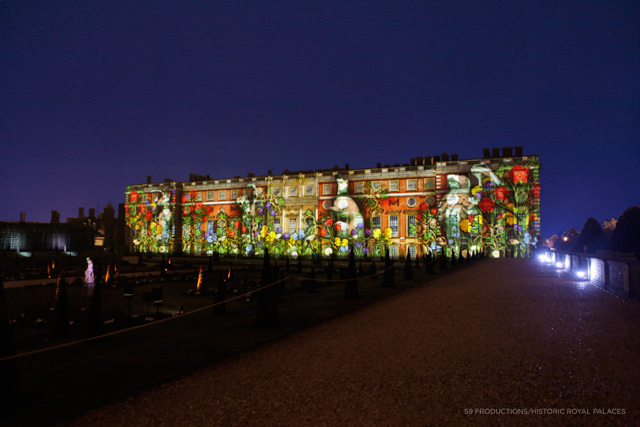
Hampton Court Palace 500th anniversary. Tudor Patterns. 59 Productions.
VS: That deals with storytelling and sound, but what about visual inspirations. Which aspect of the visual arts do you find most exciting?
LW: The crossover world where architecture and light and colour overlap. I’m a fan of Olafur Eliasson and Richard Serra – I’m just in awe of people who make works that are almost pure sculpture, but also architectonic. Also, Bill Viola, who is the godfather of video art in a way. When we did the Guggenheim anniversary, his show was on and it was the best installation of his work I had ever seen.
VS: Has your use of technology, or the tools you use, evolved massively in the last five years?
LW: I’m not inherently interested in technology. I don’t feel, to be honest, that there has been a silver bullet that has revolutionised anything in the last five or 10 years. We switched to a new type of media server about five years ago, which is incredible. As all software tools do, it has its quirks. But it has these pre-visualisation tools within it that allow us to get a really good head start on a project before we show up on site, which is very important because we have very short install times. Things like that have made incremental changes to our workflow.

Hampton Court Palace 500th anniversary. Closing ceremony. 59 Productions.
VS: Has having your own architecture department made a big difference?
LW: That has been enormous. That has revolutionised our workflow. Partly because it’s such a brilliantly systematised discipline, so some of the systems (we use) we have lifted from the architectural world and deployed within the company. Things such as a really clear phasing of the design process, acknowledging that the design process will always have a very sketchy phase and then a concept phase, which is more fully fleshed out, and then a scheme phase, which is essentially a reiteration of the concept but has reality applied to it, and then the detail phase, which is about finishes, materials, details, technical drawings and so on. It is about acknowledging and enjoying the fact that design doesn’t just come out of thin air. It should be considered like sculpting.
Now the 3D volumetric thinking happens as part of the conceptualisation process as opposed to a slightly later stage. Now pretty much the whole design process is a 3D workflow. Also, the company is orienting itself towards taking bigger and bigger creative responsibility for projects. So we’re not outsourcing or being brought in as a third party to architectural or scenic design work that has already been done. Mostly, we don’t want to be subservient to someone else’s design process and now we can do all of that, which is immensely enabling.
VS: What about the way in which the architecture itself is changing. Offsite work has become so interesting, but also the architecture of performance spaces is shifting, as with the Shed. I went to a talk at the Royal Academy this year where Liz Diller (of the Shed’s creators, Diller, Scofidio + Renfro) said: “We have no idea what forms of entertainment are going to be conjured in the future.” What do you think is in store?
LW: I don’t know if I am convinced by the Shed. I haven’t seen it since it opened, but I went and had a look around the outside of it. The telling thing is that the first thing they did was hang black curtains and turn it into an end-on proscenium. You know, there is a good reason that theatres are designed around seats facing in one direction, largely, with a framing device and all the technical stuff around it. You know where to focus your energies. As soon as people say we’ll do everything everywhere, you have to ask: can you spread yourselves that thin? Can you have properly loaded winches everywhere in the auditorium? Can you have enough lighting bars, enough electricity, enough whatever. Flexibility is all very well if you’re designing it for a purpose. But if you’re saying: anything will be possible - will it? It won’t. Some specific things will be possible, so why don’t you design it around those things.
VS: So what needs to be driving that ambition to use these spaces in different ways?
LW: I suppose what I’m interested in is what we did with Invisible Cities, which was build a theatre. It was a response to the Mayfield space. However, we are rebuilding that same theatre in a warehouse in Brisbane in five weeks’ time. It will carry the essence of Mayfield with it. Interestingly, I was inspired by Mayfield to make the show in ways that we couldn’t have achieved without that space. However, I’m now comfortable about it being in other spaces that aren’t the same. When you know what it is, as a part of the devising process if you like, then you realise what all the things you need to do are, and then you transpose them to other spaces. Therefore I’m interested in starting with the production and building out from there.
I mean, let’s build our own theatres, frankly. But let’s build them based on the production we want to make, not on a catch-all proposition. Which is why I quite like the fact that our theatres are sometimes the Washington Mall, or the Mayfield or the Guggenheim.
VS: What exciting new projects are coming up?
LW: We are very excited about going to Washington, to be part of a globally significant event. But I’m excited about lots of things. One of the things is working with this theatre in Kuwait where there have been a number of productions now. I mean, there used to be a theatre industry and then there wasn’t. They are rebuilding it by working with international partners like us, but also locals. They are trying to kickstart a new generation of Kuwaiti performers, actors and musicians. It’s not without massive problems. Jointly, we overcome those problems to make this work.
VS: How do you balance concerns about the political freedoms – or lack of them – in places where you might be invited to make work?
LW: It’s very complex, obviously, where one chooses to work and where one chooses not to work and how one makes those decisions. Broadly speaking, I think any type of cross-cultural dialogue is a positive thing. In making work, which will be collaborative across multiple cultures, that dialogue is being on some level taken forwards. To provide the work itself is interesting. Any of that is a broadly positive thing. The more we can be in conversation with each other more of the time, the better.